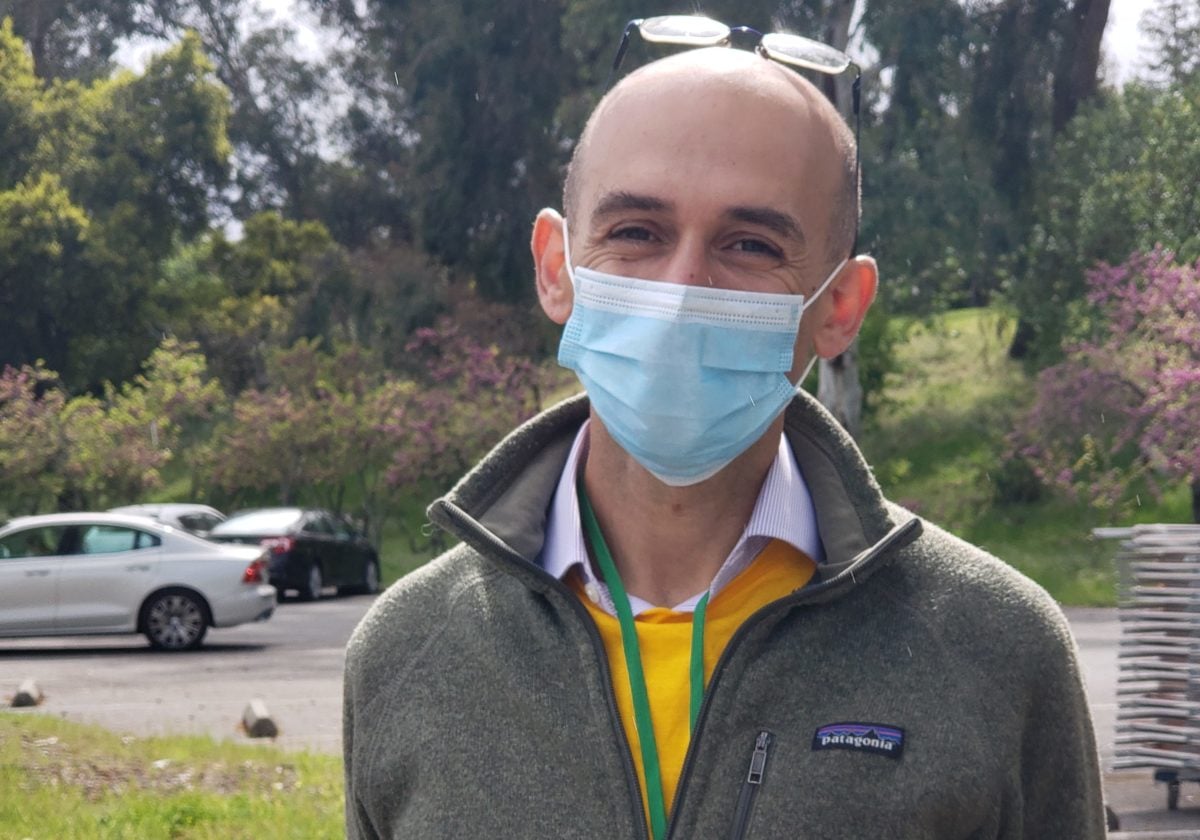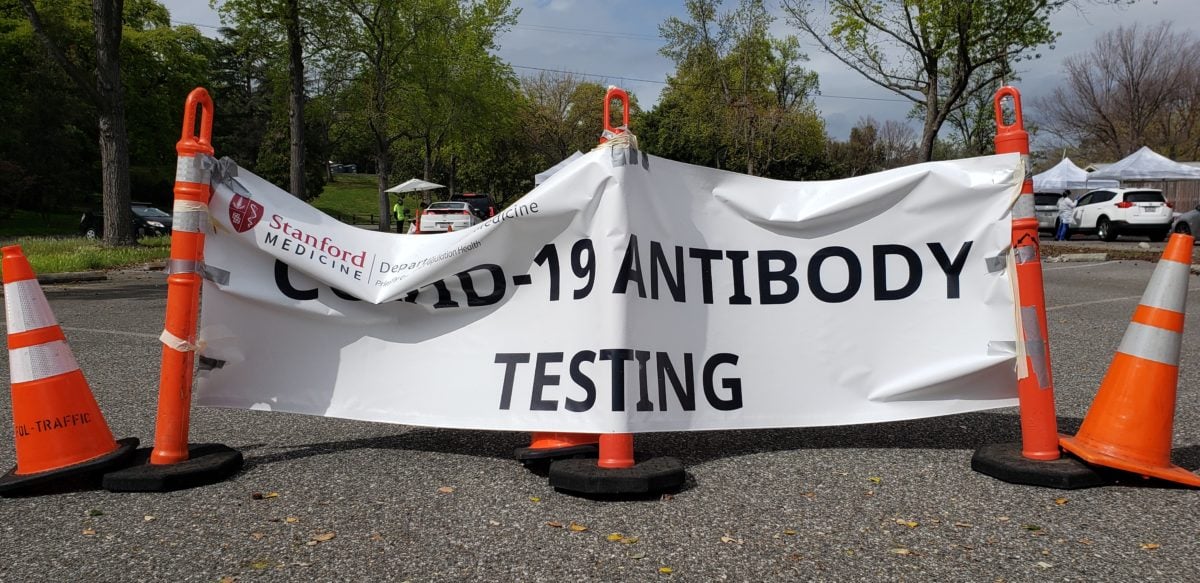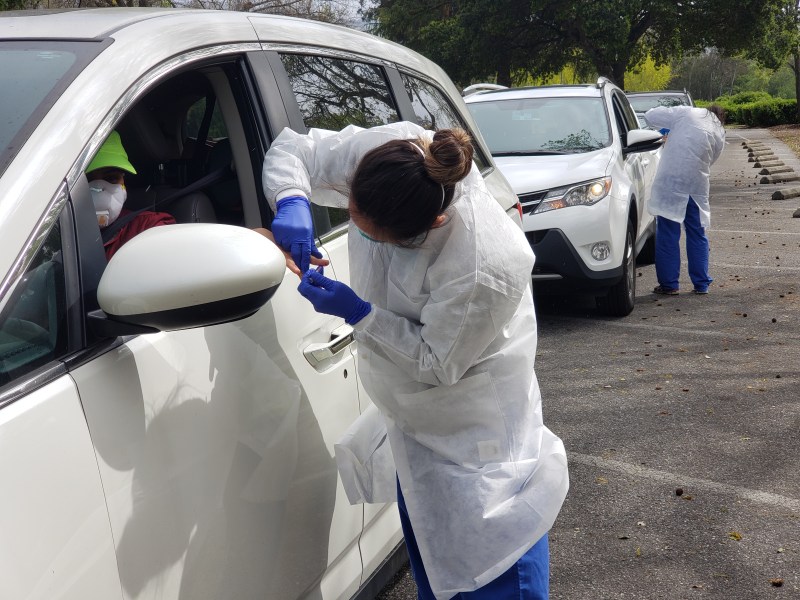Over 3,200 people in Santa Clara County were tested for COVID-19 antibodies on Friday and Saturday in an effort to determine the proportion of the population that either has or has recovered from coronavirus. The study, led by researchers at Stanford Medicine, is the first of its kind in the nation.
The results, expected to be released within a week, could be used to guide future public health policy in the county, according to associate professor of medicine and study co-lead Eran Bendavid.
“It’s hard to stand up in this epidemic and say, ‘Look, we really don’t know if this epidemic is impending Armageddon,’” Bendavid said. “In order to know and reduce that uncertainty, you need numbers.”
COVID-19 antibody tests differ from nasal swab tests currently employed by healthcare providers both in method and results. Nasal swab tests take samples from the back of the throat — leading some to characterize the experience as “being stabbed in the brain” — and determine whether live coronavirus is present in the body. The antibody tests used in the Stanford study, which were supplied by Premier Biotech, require only a fingerstick of blood and test for IgM and IgG antibodies that indicate that a person either has coronavirus or had it and recovered.
Widespread antibody testing is also taking place in Colorado’s San Miguel County, where all residents will be provided with tests donated by United Biomedical executives who live in the county. Another coronavirus seroprevalence study will be conducted in Los Angeles next week, according to Bendavid.
“It’s kind of a useless test for a hospital, but it will give us a better idea of how many people have been exposed to the virus and how bad the fatality rate is,” said Rodrigo Saavedra, who led the Hellyer Park testing site in San Jose. “Right now there is a measure of fear among the general population which might not be totally substantiated.”
In addition to the Hellyer Park location, clinical and nonclinical volunteers, interpreters and lab staff worked together to perform tests at Vasona Lake County Park in Los Gatos and at the First Presbyterian Church of Mountain View. Bendavid was joined by Soleil Shah M.D. ’23 and Bianca Mulaney M.D. ’23 in running logistics between the three sites.
Study participants were compensated for their time with a $10 Amazon gift card. They will also be called about their results within the week if they tested positive for the antibodies, Bendavid anticipates.
Andrew Bogan, who aided Saavedra in running the Hellyer Park site, said site leaders took precautions to ensure safety for both the participants and volunteers.
“I’m the guy who’s been walking around saying ‘six feet, six feet, six feet’ all day long for the last two days,” Bogan said. “Everybody is operating under both county and CDC guidelines, to the best extent possible. Obviously, there has to be direct contact to take patient samples, but people are directly protected with PPE [personal protective equipment].”
Participants, volunteers happy to be outside
Bendavid said that he was concerned about finding the 200 to 300 volunteers necessary to run the study — potentially risking their health in the process — and had been taken by surprise by the upbeat morale across testing sites.
“People have been inside and away from each other for so long, and this study has let people hang out and be with each other,” Bendavid said. “It makes me miss the regular world.”
Study participants were similarly enthused. The researchers attempted to recruit a set of participants representative of the country’s demographics through targeted ads on Facebook, according to Bendavid.
“This service exploded,” Bendavid said. “The number of participants doubled every few minutes. We were seeing them in real time, and I was panicking. I said, ‘Close [registration] right now. Take it off so that we can re-evaluate.’”

Vasona Site Leader Cara Lai, who is also a fourth-year medical student at Stanford, said that the study participants were “really, really gracious,” even though it could take up to an hour and a half to get sampled.
“Everyone is excited to be a part of this, whether they’re volunteering or participating,” Lai said. “People are excited to be outside and excited to sit in their cars since at least they’re outside and leaving the house.”
Study volunteer and eighth-year M.D./Ph.D. candidate Brian Hsueh said his conversations with study participants while taking samples reinforced his confidence in his decision to be a doctor.
“Thankfully, for the most part, people say, ‘Yeah, I’m just at home bored, and this is the first time I’ve been out in weeks,’” Hsueh said. “But at the same time, I’ve also had people come by who tell me things aren’t going well, like, ‘My wife has COVID, and she’s in the ICU.’ It’s a broad spectrum.”
Study volunteer and fifth-year M.D./Ph.D. candidate Michelle Drews added that volunteering was “a good way to help and give back,” especially after Stanford released research guidelines that prevented her from experimenting on the stem cells she has been growing for the past nine months.
“It’s been a lot of learning on the job, but it’s been fun,” Drews said, explaining that Thursday morning had been her first time taking a blood sample using a fingerstick instead of drawing blood through a vein on the arm.
A “whirlwind” path to study approval
The path to study approval was a “whirlwind,” according to Bendavid. The study gained funding and Stanford Institutional Review Board approval in only two weeks.
But it ran into “only about 100” roadblocks a day, Bendavid said, ranging from shortages of PPE and the collection tubes used to hold the blood to coordinating overflow between sites.
During the study, Lai commended her volunteers for jumping to action after the Vasona site ran concerningly low on the tubes used to hold the blood samples.
“Our volunteers just mobilized,” Lai said. “People tweeted, people sent out texts and people spammed email lists. People really stepped up, and we got donations of the collection tubes that we needed.”
At Hellyer, Saavedra said his team ran into difficulties with study participants turning the heat up in their car, which could blow virus particles into the faces of volunteers when they rolled their windows down to give a sample. In response, volunteers urged study participants to turn their heaters off when giving a blood sample and offered hand warmers to those who were cold.
Even the Facebook ad campaign to find study participants necessitated troubleshooting.
The researchers attempted to launch the Facebook ads on Wednesday night, but soon hit a roadblock when the new account it used to purchase ads was flagged for review, according to Bendavid.
“Thursday morning, we wake up, and our ad hasn’t been posted,” Bendavid said. “We start frantically calling people that we know, and within 20 minutes, we managed to get someone who was [Facebook Chief Operating Officer] Sheryl Sandberg’s foundation’s director who called Sheryl Sandberg and said, ‘Can you help these guys?’”
The ad was prioritized in the approval process and released 20 minutes later, according to Bogan.

A previous version of this article incorrectly stated that the third testing site was in Menlo Park, not Mountain View. The Daily regrets this error. This article has also been clarified to reflect that the researchers’ ad was prioritized for approval as a result of the phone call.
